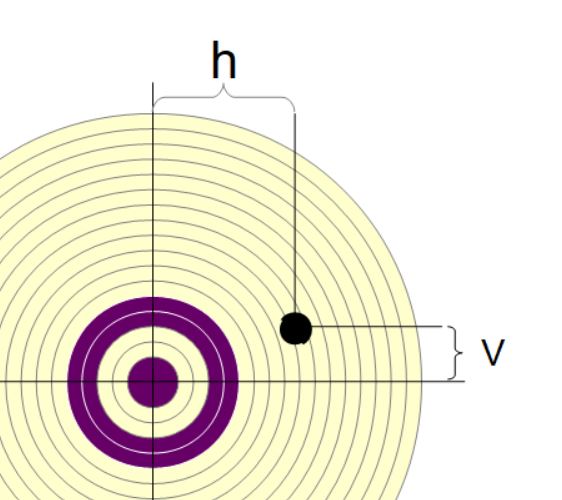The Greenhill Rifling Formula calculates the optimal barrel twist rate for stabilizing a bullet's flight given the bullet's diameter(D), length(L), specific gravity (SG) and velocity(V). The resulting twist rate is the length in which the rifling of the barrel will make one full rotation.
INSTRUCTIONS: Choose units and enter the following:
- (D) Diameter of Bullet
- (L) Length of Bullet
- (SG) Specific Gravity of bullet's material. Note: a default of 10.9 is provided for the SG of a lead-cored bullet.
- (V) Muzzle Velocity of average round.
Optimal Barrel Twist Rate (TR): The calculator computes the length (TR) for one complete rifling rotation in inches. However this can be automatically converted to other length units via the pull-down menu.
The Math / Science
The Twist Rate is commonly written as a ratio. Some common rifling ratios are 1:7, 1:9, 1:36, where 1:7 corresponds to 1 turn in 7 inches.
The constant C corresponds to the velocity at which the bullet is fired. For velocities up to 2800 ft/s 150 is used. For anything higher 180 is used.
The Greenhill Riffling Formula used in this calculator is:
`TR = (C*D^2) / L * sqrt((SG)/10.9)`
where:
- TR = Twist Rate ratio for a riffled barrel
- C = Factor associated with muzzle velocity. It's 150 for muzzle velocities under 2,800 ft/s and 180 otherwise.
- D = Diameter of Bullet
- L = Length of Bullet
- SG = Specific Gravity of Bullet Material.
Here is an interesting article on why proper bullet stabilization matters: http://www.ammoland.com/2017/02/ar-15-barrel-twist-rates-you-need-to-know/#axzz4alKeEk8o

Firearm Calculators
- Sectional Density: Computes the factor used in the computation of the ballistic coefficient called sectional density.

- Bullet Ballistic Coefficient: Computes factor that represents a bullet's ability to overcome air resistance in flight.
- Ballistic Coefficient from Bullet's Mass, Diameter and Form Factor: Estimates the ballistic coefficient from the mass, diameter and form factor
- Miller Twist Rule: Computes the optimal barrel twist rate for stabilizing a bullet's flight given the bullet's diameter, length and mass.
- Taylor Knock-out Factor: Calculates a factor indicating the power of a round,.
- Greenhill Formula for Optimal Rifling Twist Rate: calculate the optimal barrel twist rate for stabilizing a bullet's flight given the bullet's diameter, length, specific gravity and velocity.
- Bullet Flight Range: Computes the maximum range (horizontal distance) traveled by a bullet based on the muzzle velocity, elevation angle and shooter height.
- Muzzle Energy of a Projectile: Calculates the kinetic energy in a bullet immediately after leaving the barrel given the bullet's mass and velocity.
- Recoil Velocity of a Gun: Computes the velocity at which a gun will move in the opposite direction in relation to the projectile that it fired.
- Cost per Round: Computes cost per round of ammunition based on the cost of a container of cartridges and the number of rounds in the container.
 Rifle Sight Correction Angles: Computes the Minutes of Angle corrections for rifle sights.
Rifle Sight Correction Angles: Computes the Minutes of Angle corrections for rifle sights.- Shotgun Shell Reloading Cost: Computes the cost to reload used shotgun shells (hulls) with powder, shot, wads and primers.
- Shotgun Shell Loading Cost: Computes the cost to load new pre-primed shells (hulls) with power, shot and wads.
- Metal Ball Weight: Computes the mass (weight) of a spherical metal (e.g., steel) ball based on the size (diameter).
- Metal Cylinder Weight: Computes the mass (weight) of a metal cylinder based on the size (diameter and length).
References
Further Information: